
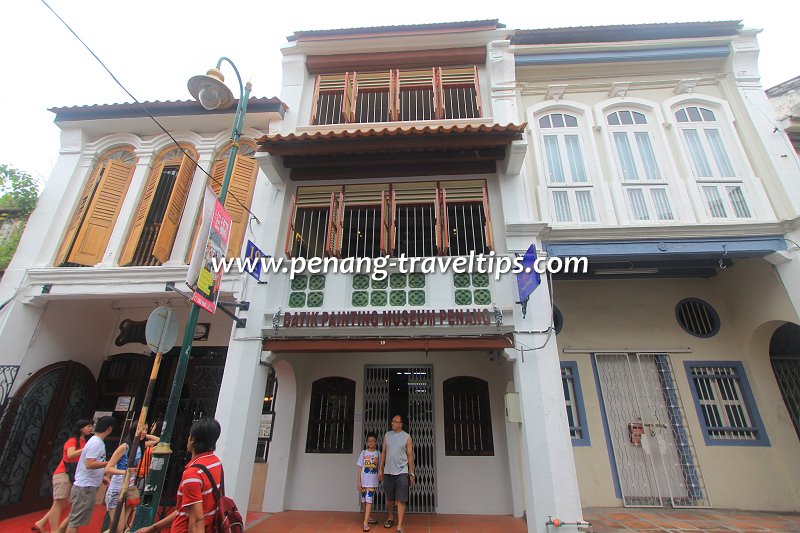 Batik Painting Museum Penang (23 March 2013)
Batik Painting Museum Penang (23 March 2013)
Batik Painting Museum Penang (GPS: 5.41493, 100.33778) is a specialty museum along Armenian Street, in George Town, Penang. It is a manifestation of the love for batik by art patron Dr Tan Chong Guan. The museum occupies a three-storey Straits Eclectic-style shophouse at 19 Armenian Street.
Purchased in 2010, the museum underwent a three-year restoration before having its soft opening on 1 October, 2013. The museum fulfills Dr Tan's desire of founding a museum that showcases the history of batik in Malaysia. This is probably the first and only museum of its kind in the country. The museum showcases many of the art pieces by artists who were central in making batik an artform. There is about 70 pieces of batik paintings exhibited on three levels.
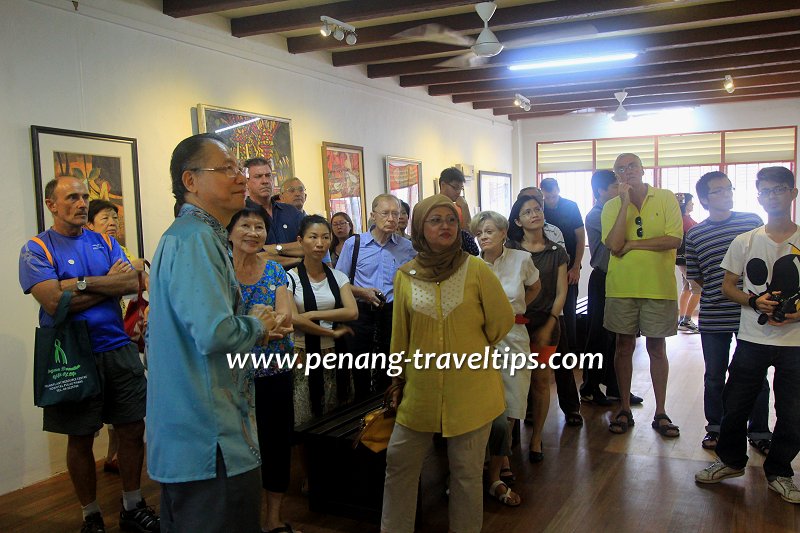 Dr Tan Chong Guan, founder of the museum, interpreting the batik pieces for the benefit of members of Penang Heritage Trust (6 October 2013)
Dr Tan Chong Guan, founder of the museum, interpreting the batik pieces for the benefit of members of Penang Heritage Trust (6 October 2013)
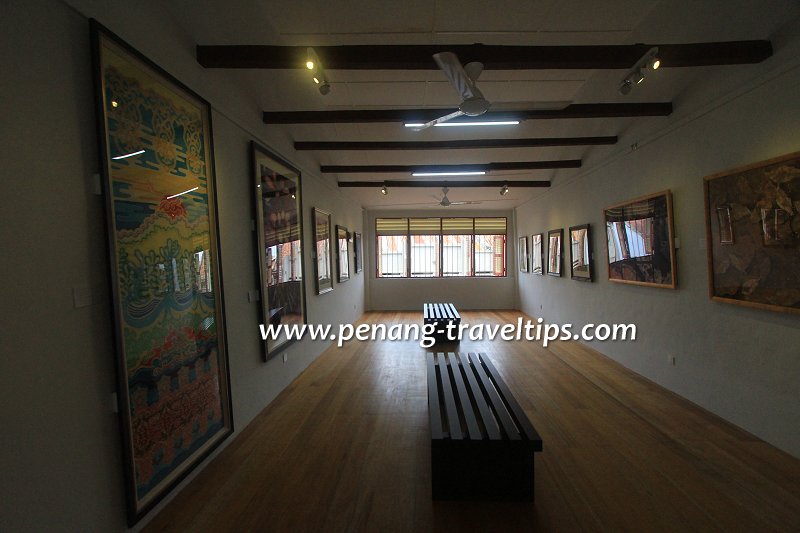 Batik Painting Museum Penang gallery (6 October 2013)
Batik Painting Museum Penang gallery (6 October 2013)
Dr Tan Chong Guan has had an interest in the fine arts for decades. He began cultivating an interest for batik in the 1970s, and since then, had assembled an impressive collection of work by various local as well as a few foreign artists. In the 1950's, when Dr Tan was still studying at the Han Chiang High School, he had had the privilege of having for his art teacher, the late Dato' Chuah Thean Teng. Although the then Mr Chuah was at the threshold of developing batik as an artform, he did not teach the batik painting techniques he was developing to his school students. And he would not have known that one of his students would one day become among his most ardent fans and patrons.
Although batik is often regarded as originating from Indonesia, its use as an art medium began in Malaysia, and particularly in Penang. Dato' Chuah, or popularly known simply as Teng, was central to the development.
About Dato' Chuah Thean Teng
The China-born Teng had studied art at the Amoy Art School, in Xiamen, China. After migrating to Malaya, he worked as an art teacher in school. As he explored the various art mediums, he observed that while batik was often used for utilitarian purposes - in the printing of sarongs, for example, it wasn't developed as an artform. This provided him the impetus to experiment with the medium.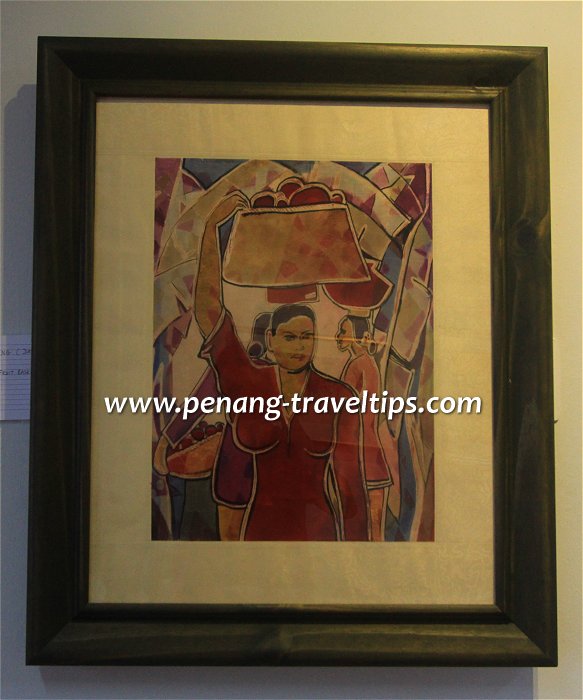 Dato' Chuah Thean Teng: Woman with Fruit Basket (1950) (6 October 2013)
Dato' Chuah Thean Teng: Woman with Fruit Basket (1950) (6 October 2013)
One of the earliest examples of batik art exhibited at the Batik Painting Museum Penang is Dato' Chuah Thean Teng's Woman with Fruit Basket, a batik-on-silk piece. Completed in 1950, it shows one of the earliest use of batik as an artform. At that time, the style is still a transition between regular painting and batik.
Another of Teng's early work, Bullock Cart, a batik on cloth, also from the 1950's is yet another example of the early development of batik.
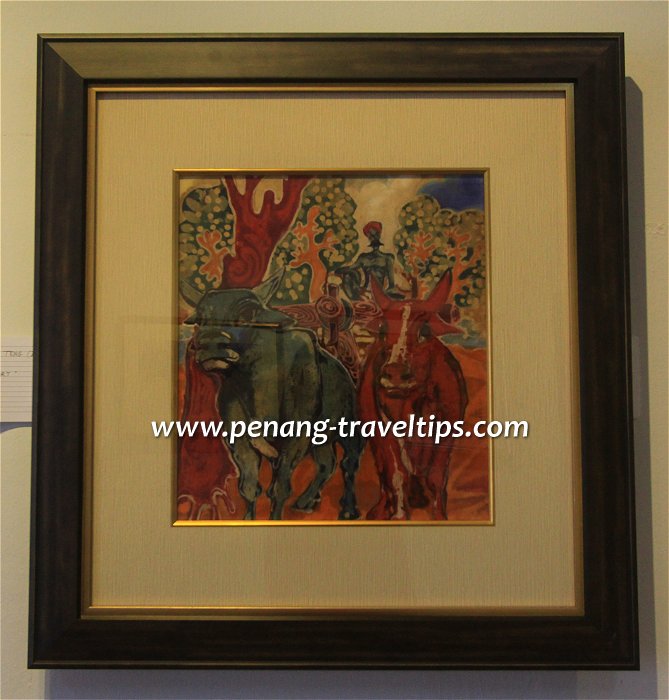 Dato' Chuah Thean Teng: Bullock Cart (1950's) (6 October 2013)
Dato' Chuah Thean Teng: Bullock Cart (1950's) (6 October 2013)
Even in the early period of developing the batik painting artform, Teng had experimented with abstract works. One of those in the museum's collection is In the Art Studio, a batik-on-cloth piece.
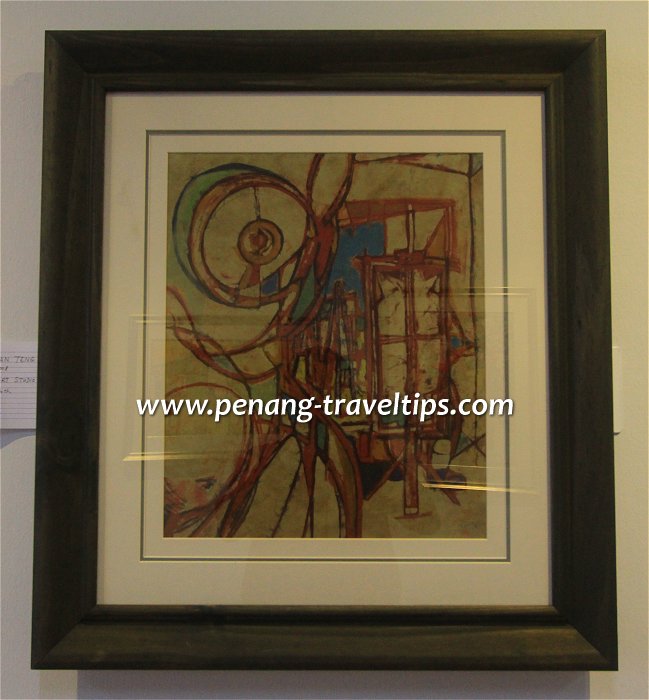 In the Art Studio (1950's) (6 October 2013)
In the Art Studio (1950's) (6 October 2013)
Even in the 1950's, Teng was already pushing the boundaries of the batik painting medium, coming out with creative methods to produce intricate batik patterns. In the seemingly simple Chickens, a batik-on-cloth piece, this can be seen in the highly involved plumage of the chickens.
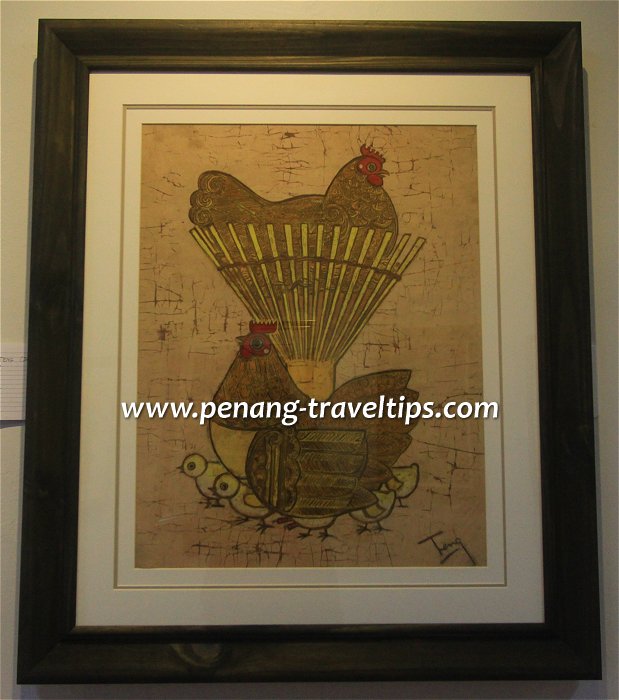 Dato' Chuah Thean Teng: Chickens (1950's) (6 October 2013)
Dato' Chuah Thean Teng: Chickens (1950's) (6 October 2013)
The stylized figures that were to become Chuah Thean Teng's hallmark first manifested in the 1960s. Though China-born, Teng is remarkably observant of the way of life in Malaya, and absorb these for his paintings. He probably drew inspiration from other tribal works of art, judging from the way he drew the eyes and the lips in his figures. This form of batik painting was eventually emulated by other batik painters.
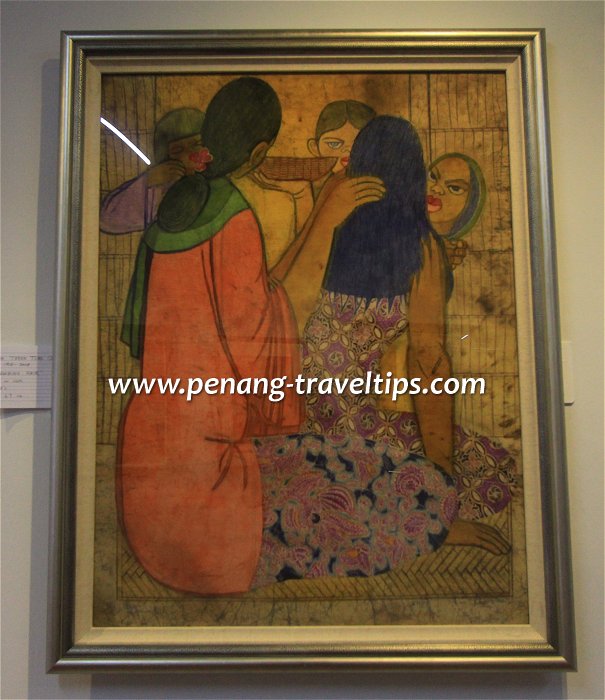 Dato' Chuah Thean Teng: Combing Hair (1960's) (6 October 2013)
Dato' Chuah Thean Teng: Combing Hair (1960's) (6 October 2013)
The choice of natives as the subject provides the opportunity to showcase intricate batik in the form of the sarongs and other fabrics worn by them. An example of this, from the 1960s, is Combing Hair, a batik on cloth.
Also in the 1960's, Teng began framing the subject into a circle. The piece Women at Home, a batik on cloth from that period, shows three women framed into a circle. The pattern on the sarong of the woman on the left is mirrored by that on the right.
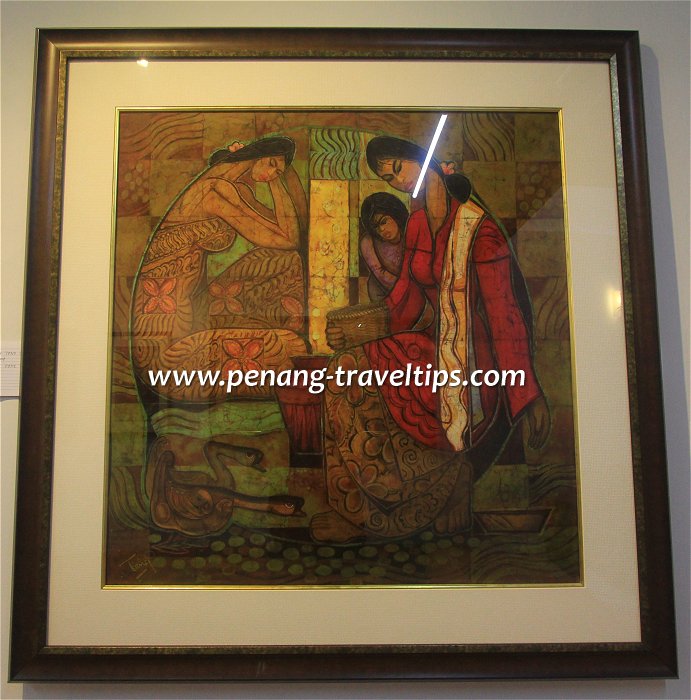 Dato' Chuah Thean Teng: Women at Home (1960's) (6 October 2013)
Dato' Chuah Thean Teng: Women at Home (1960's) (6 October 2013)
About Dato' Tay Mo-Leong
While China-born Dato' Chuah Thean Teng is credited with pioneering the use of batik as an artform, the most influential Penang-born batik artist is undoubtedly Dato' Tay Mo-Leong. Representing a generation down from Teng, Dato' Tay studied art at the Provincial Taipei Normal College. This perhaps explains the Chinese influences reflected in the early batik pieces of this Chung Ling Secondary School alumnus.Upon his return from Taiwan, Tay apprenticed under Teng for a while, hoping to learn something. However, he discovered that he could not pry any techniques from the master, so he resolutely set forth to develop his own style of batik painting.
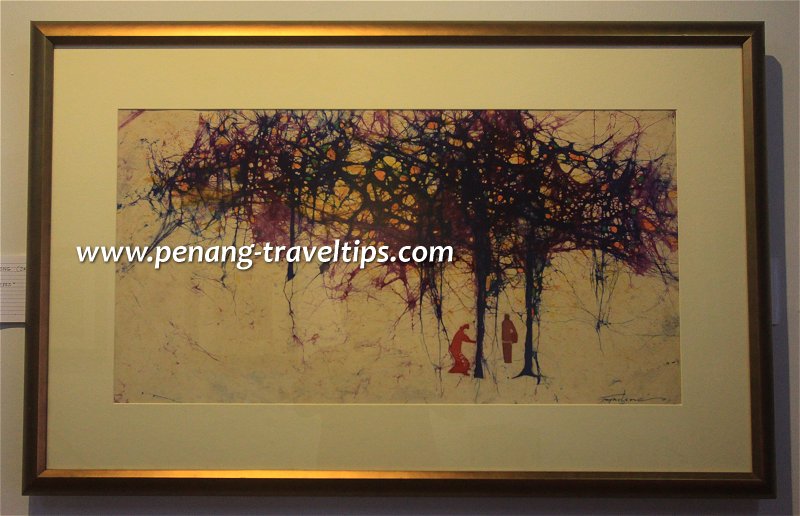 Dato Tay Mo-Leong: Rubber Trees (1961) (6 October 2013)
Dato Tay Mo-Leong: Rubber Trees (1961) (6 October 2013)
One of Dato' Tay Mo-Leong's earliest pieces is Rubber Trees. This batik-on-cloth piece was done in 1961, when Tay was just 23 years old, and had recently returned from Taiwan. How he rendered the two rubber trees reflects the influences he received from Chinese ink-style paintings.
Dato' Tay's early pieces from the 1960's tend to be restrained in the use of batik. It was also a period where he was still finding his style, and deciding how best to showcase the medium. The piece Kampong House from 1963, is a batik on cloth that looks almost like an acrylic painting.
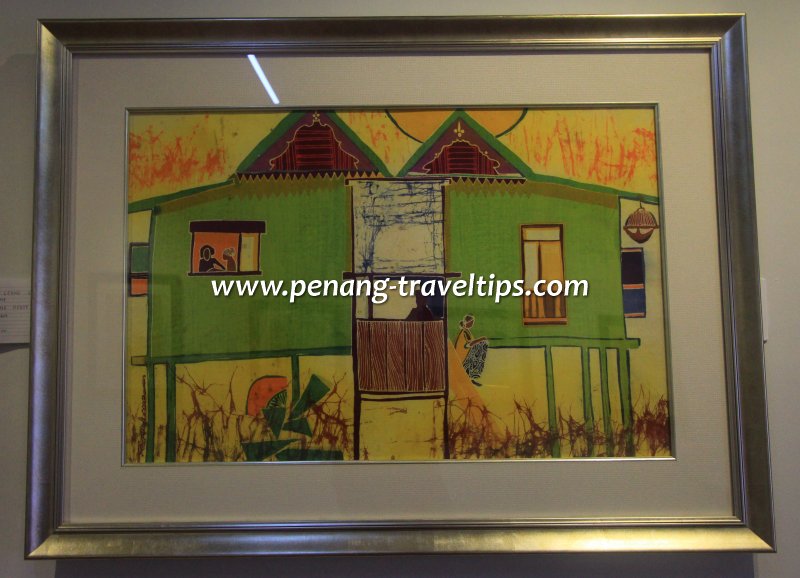 Dato Tay Mo-Leong: Kampong House (1963) (6 October 2013)
Dato Tay Mo-Leong: Kampong House (1963) (6 October 2013)
The hallmark of Dato' Tay's batik pieces is the cracking style he employs to the background. We see this in his early piece, Rubber Tree as well as Kampong House. It manifests itself once more in Japanese Dolls, one of two pieces which Tay painted for an exhibition in Japan in 1966. Dr Tan Chong Guan manged to get Dato Tay to sell him this piece to be exhibited at the Batik Painting Museum Penang.
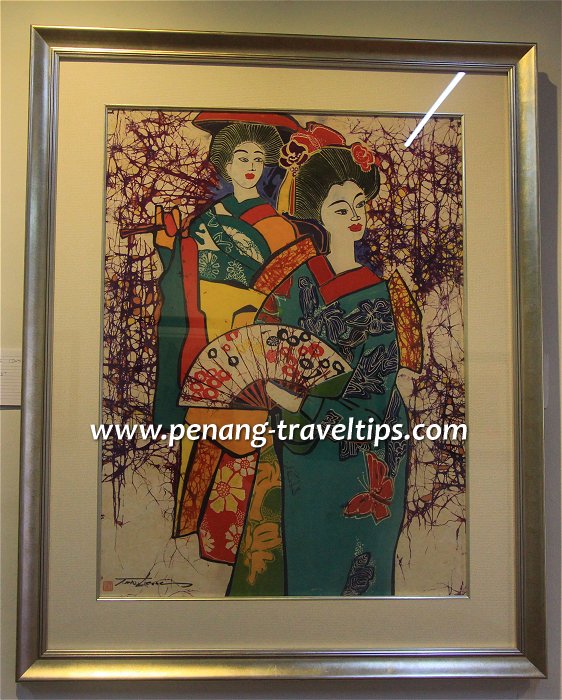 Dato' Tay Mo-Leong: Japanese Dolls (1966) (6 October 2013)
Dato' Tay Mo-Leong: Japanese Dolls (1966) (6 October 2013)
The use of batik as an artform was gathering popularity by the late 1960s, so when the Rasa Sayang Hotel was being constructed, the hotel commissioned Tay to paint six batik pieces. Tay did seven. Dr Tan managed to get Tay to sell him that one remaining piece that did not go to the hotel.
Known simply as Landscape, this batik on cloth from 1969 is now exhibited alongside other early works by Tay. This piece reflects the evolution of Tay's style, moving away from the Chinese ink painting influences of his early works, towards more indigenous motifs.
By 1970s, Tay was creating increasingly sophisticated batik paintings. They reflect local as well as foreign influences. Balinese motifs became a recurring theme for many of Tay's pieces during this period, a couple of which can be seen in the museum. One of these is a gorgeous piece on cloth, called Bali Festivity.
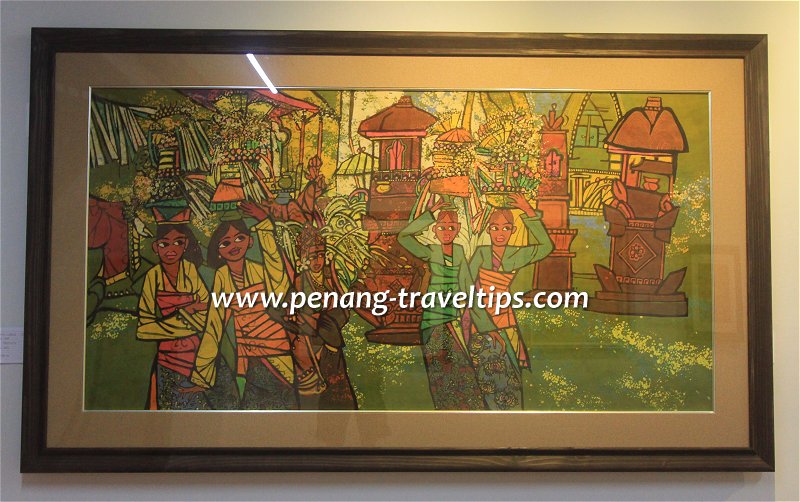 Bali Festivity (6 October 2013)
Bali Festivity (6 October 2013)
In recognition of their contribution to the development of batik, Chuah Thean Teng and Tay Mo-Leong were two of three artists honoured by the country in 2004, the other one being Khalil Ibrahim, mentor to Ismail Mat Hussin.
Other Artists
Dato' Chuah Thean Teng and Dato' Tay Mo-Leong are certainly not the only artists exhibited at the Batik Painting Museum Penang. A contemporary of Dato' Tay is Lim Khoon Hock, better known as Toya, a batik painter renowned for his experimentation with the medium. Many of Toya's pieces can be described as a fusion of styles, pushing the limit of what could be called batik. Among his works exhibited at the museum include At the Beach, a batik on cloth from 1968, and Goats, another batik on cloth, from 1969.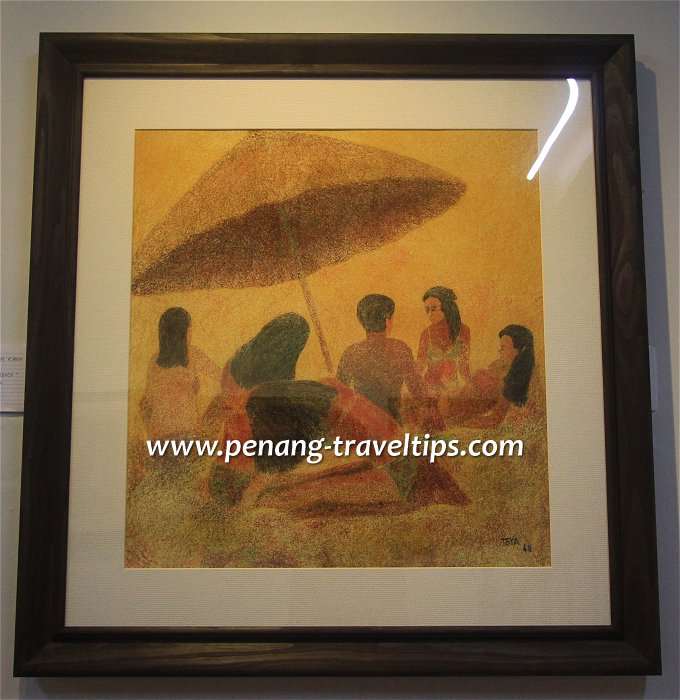 Toya Lim Khoon Huat: At the Beach (1968) (6 October 2013)
Toya Lim Khoon Huat: At the Beach (1968) (6 October 2013)
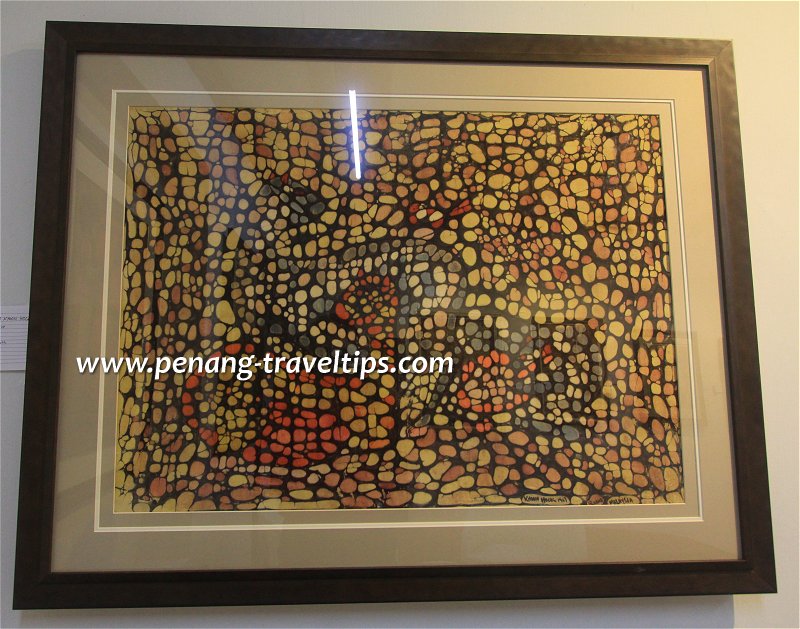 Toya Lim Khoon Huat: Goats (1969) (6 October 2013)
Toya Lim Khoon Huat: Goats (1969) (6 October 2013)
Like myself, the museum owner was a former council member of the Penang Heritage Trust. However, I did not know that the PHT manager's late father was an artist. That was a most pleasant surprise to me, when Dr Tan showed two pieces by by the late Ho Hee Khim. The subject of both pieces, painted in the 1990's, was orchids.
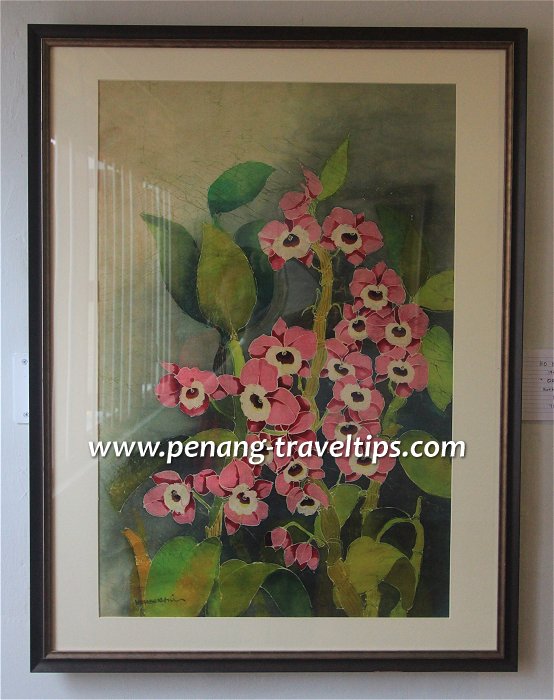 Ho Hee Khim: Orchids (1990's) (6 October 2013)
Ho Hee Khim: Orchids (1990's) (6 October 2013)
Today, perhaps the most masterly living practitioner of the art of batik painting has got to be Ismail Mat Hussin. His pieces tend to be highly evocative and ultimately mersmerizing. They reflect his love for details and a clear passion for rural life.
As with Dato' Tay Mo-Leong and Toya Lim Khoon Huat, Ismail Mat Hussin was born in Pantai Sabak, Kota Bharu, in 1938. However, he was still actively painting, and continues to produce masterpieces right into his seventies. Among his batik-on-cloth pieces at the museum include Market Place, from 2005, Two Trishaws from 2008, and After the Catch, from 2009.
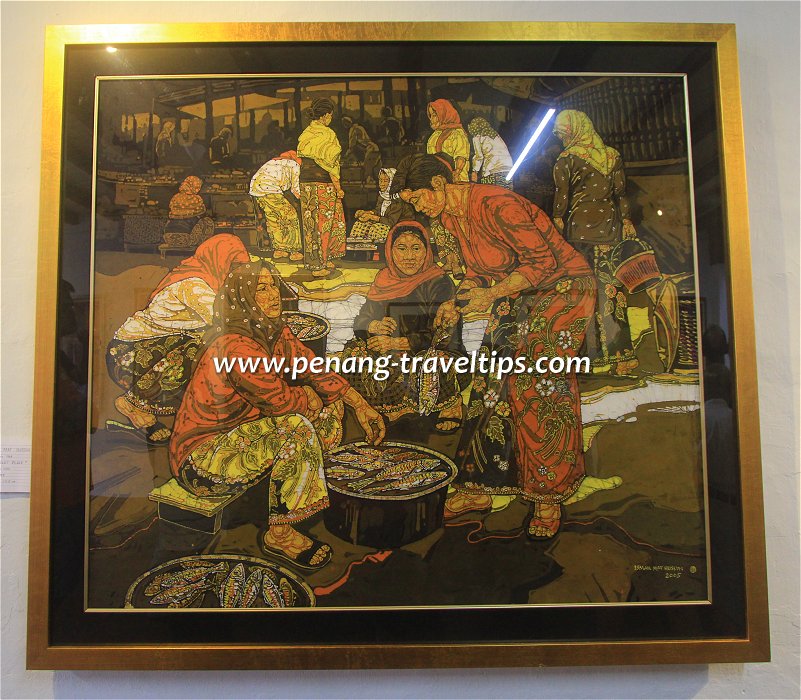 Ismail Mat Hussin: Market Place (2005) (6 October 2013)
Ismail Mat Hussin: Market Place (2005) (6 October 2013)
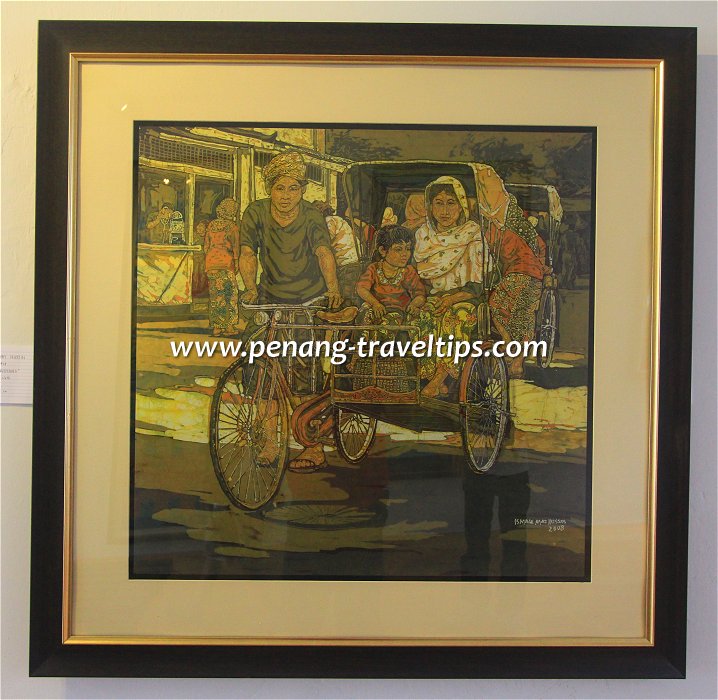 Ismail Mat Hussin: Two Trishaws (2008) (6 October 2013)
Ismail Mat Hussin: Two Trishaws (2008) (6 October 2013)
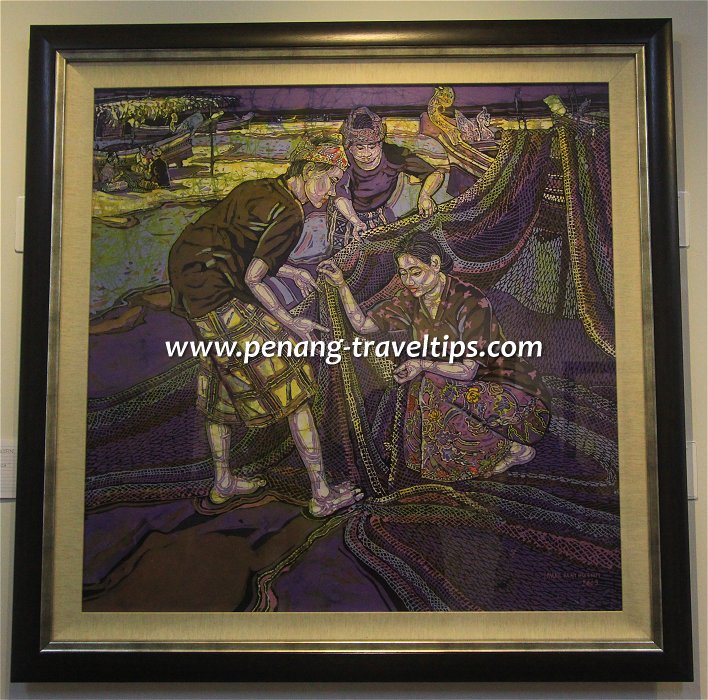 After the Catch (6 October 2013)
After the Catch (6 October 2013)
Visitor Information
Batik Painting Museum Penang19 Armenian Street
10200 George Town, Penang
Phone: +60 4 262 4800
Email: batikpg@gmail.com Website: www.batikpg.com
Opening Hours
Mondays - Fridays: 10:00 am - 5:00 pm
Saturdays: 10:00 am - 3:00 pm
closed on Sundays and public holidays
Admission: RM5.00
Getting there
The Batik Painting Museum Penang is reachable on foot from the Weld Quay Ferry & Bus Terminal. Cross Weld Quay by the pedestrian bridge then turn left and walk along Weld Quay until you reach the junction with Armenian Street Ghaut on your right. Go along Armenian Street Ghaut, which after the intersection with Beach Street continues as Armenian Street. The museum is on the left side of Armenian Street, a short distance from the Beach Street intersection.Location of the Batik Painting Museum on the map
Acknowledgement
Penang Travel Tips expresses its thanks to Dr Tan Chong Guan for graciously opening the Batik Painting Museum Penang and for providing the details in this article.List of Museums in Penang and Museums in Malaysia
Private Guided Tours of Penang
If you are seeking private guided tours of Penang, message Penang Tour Guides at penangtourguides@gmail.com and enquire with them. Buy, rent or sell properties in Penang
Buy, rent or sell properties in Penang
Do you have a property for sale or to rent out? Are you looking to buy or rent a property? Get in touch with me. WhatsApp me (Timothy Tye) at 012 429 9844, and I will assign one of my property agents to serve you. I will choose the agent for you, according to your property needs. So when you message me, provide me some details of what you need, whether to sell, to buy, to rent or to rent out, and what type of property, is it condo, apartment, house, shop, office or land. Latest updates on Penang Travel Tips
Latest updates on Penang Travel Tips
 Map of Roads in Penang
Map of Roads in Penang
Looking for information on Penang? Use this Map of Roads in Penang to zoom in on information about Penang, brought to you road by road.About this website

Dear visitor, thank you so much for reading this page. My name is Timothy Tye and my hobby is to find out about places, write about them and share the information with you on this website. I have been writing this site since 5 January 2003. Originally (from 2003 until 2009, the site was called AsiaExplorers. I changed the name to Penang Travel Tips in 2009, even though I describe more than just Penang but everywhere I go (I often need to tell people that "Penang Travel Tips" is not just information about Penang, but information written in Penang), especially places in Malaysia and Singapore, and in all the years since 2003, I have described over 20,000 places.
While I try my best to provide you information as accurate as I can get it to be, I do apologize for any errors and for outdated information which I am unaware. Nevertheless, I hope that what I have described here will be useful to you.
To get to know me better, do follow me on Facebook!
Copyright © 2003-2025 Timothy Tye. All Rights Reserved.

 Go Back
Go Back